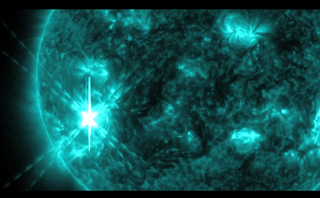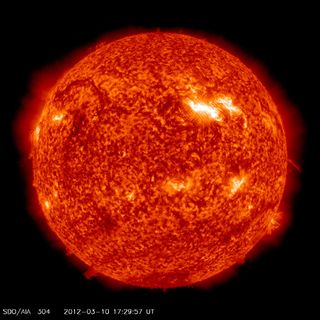Strongest Solar Flare of 2013 Erupts from Sun (Video)
The sun fired off its strongest solar flare of the year Tuesday, though the massive sun storm should not post a major concern for Earth, space weather experts say.
The powerful X3.3 solar flare peaked at 5:12 p.m. EST (2212 GMT) on Tuesday (Nov. 5) from the sunspot AR1890. NASA's Solar Dynamics Orbiter captured high-definition video of the X-class solar flare as it erupted from the sun.
The material ejected from the solar flare will probably not create issues on Earth, space weather officials said.
"No geomagnetic disturbance is expected from this event," National Weather Service Space Weather Prediction Center officials wrote in an update today (Nov. 6). "However, Region 1890 remains potent and well-positioned, so keep tabs of activity here." [Major X-Class Solar Flares of 2013 (Photos)]

X-class solar flares are considered the most powerful kinds of solar storms, and when aimed directly at Earth, they can pose a danger to satellites and astronauts in orbit. The sun is currently in the peak of its 11-year Solar Cycle 24 and unleashed several smaller X-class solar flares in late October.
The most powerful flare before Tuesday's event was an X3.2 flare in May during a hyperactive week for the sun, which included one day that saw the sun fire off three major flares. An X2 flare is twice as intense as an X1, and an X3 flare is three times as intense, according to NASA.
"Increased numbers of flares are quite common at the moment as the sun's normal 11-year activity cycle is ramping up toward solar maximum conditions," NASA officials wrote in an update today.
Get the Space.com Newsletter
Breaking space news, the latest updates on rocket launches, skywatching events and more!
While no major disruptions are expected from Tuesday's flare, the Earth will not remain completely untouched. The strong solar event caused a radio blackout, and the flare did cause a "magnetic crochet" — a disturbance in Earth's magnetic field as a flare is still in progress, astronomer Tony Phillips wrote in a update on Spaceweather.com, a website that tracks space weather and skywatching events.

A magnetic crochet is a rare cosmic sight that usually occurs during fast flares, Phillips added. Unlike coronal mass ejections, which affect Earth's magnetic field only after a flare subsides, a magnetic crochet perturbed the field during the ongoing flare, he explained.
More flares might be on the heels of this one.
"More eruptions are in the offing," Phillips wrote in his Spaceweather.com update. "NOAA [National Oceanographic and Atmospheric Administration] forecasters estimate a 45 percent chance of M-class solar flares and a 10 percent chance of X-flares on Nov. 6."
NASA and space agencies around the world keep a close eye on the sun, looking out for potentially hazardous space weather with spacecraft like the Solar Dynamics Observatory. Scientists have tracked space weather incidents since 1843.

Follow Miriam Kramer @mirikramer and Google+. Follow us @Spacedotcom, Facebook and Google+. Original article on SPACE.com.
Join our Space Forums to keep talking space on the latest missions, night sky and more! And if you have a news tip, correction or comment, let us know at: community@space.com.

Miriam Kramer joined Space.com as a Staff Writer in December 2012. Since then, she has floated in weightlessness on a zero-gravity flight, felt the pull of 4-Gs in a trainer aircraft and watched rockets soar into space from Florida and Virginia. She also served as Space.com's lead space entertainment reporter, and enjoys all aspects of space news, astronomy and commercial spaceflight. Miriam has also presented space stories during live interviews with Fox News and other TV and radio outlets. She originally hails from Knoxville, Tennessee where she and her family would take trips to dark spots on the outskirts of town to watch meteor showers every year. She loves to travel and one day hopes to see the northern lights in person. Miriam is currently a space reporter with Axios, writing the Axios Space newsletter. You can follow Miriam on Twitter.
